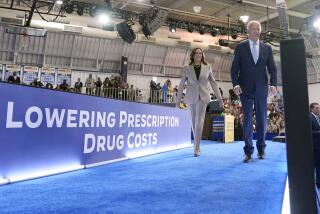Comparing Candidates’ Prescription Drug Plans
- Share via
Democratic presidential candidate Al Gore has a plan to add a prescription drug benefit to Medicare. Republican candidate George W. Bush says he’ll announce a plan next week. About 25 million people on Medicare have prescription drug coverage of some sort; 12 million people on Medicare have none.
Here are the main features of Gore’s plan, and a congressional plan that Bush says he supports in general terms:
GORE:
* Cost: An estimated $253 billion over 10 years.
For the poor:
* The elderly poor would get all their prescription drugs at no cost. If the plan were in effect this year, free coverage would be offered to anyone earning up to $11,200. Currently, state Medicaid programs help some poor seniors with drug costs; this plan would help more.
* The government would pay a portion of the premiums for seniors on the edge of poverty. This would be for someone earning $11,200 to $12,450 this year.
Here’s how the plan would work for everyone else:
* Premiums: About $25 a month in the first year, rising over 10 years to more than $40 a month.
* Coverage: People enrolled in the plan would pay half their drug costs and the government would pay the other half. The maximum benefit from the government in this cost-sharing plan would be $1,000 in the first year. That would rise to $2,500 in 10 years. But the most anyone would pay out-of-pocket for drugs is $4,000 in any one year; the government would pay anything over that.
* Enrollment: People could not wait until they got sick or very old before enrolling. They would be given a onetime opportunity to enroll when they became eligible for Medicare, currently at age 65. The only other way to join the program would be if an employer discontinued a drug plan for retirees, leaving someone suddenly without the benefit.
* How it helps:
The plan’s greatest advantage would be for poor people who get no help from state programs, and people with extraordinary prescription drug needs.
Those facing average drug costs might not benefit much. According to the Congressional Budget Office, the average Medicare beneficiary paid $673 for drugs in 1996. Gore’s plan would pay half that bill, or about $337, but require $300 in premiums, leaving the average beneficiary that year only $36 ahead.
Gore’s campaign says average drug costs have risen since then to about $1,100. In that case, the drug benefit would be worth $250 to someone with average drug needs, after the premiums and out-of-pocket expenses.
BUSH:
Bush has only offered a general description of his ideas, saying he would make sure all seniors had access to a prescription drug plan. Pressed, he said he would sign a plan offered by Sens. John Breaux (D-La.) and Bill Frist (R-Tenn.) if there were no other option, although he thought it could be improved.
The Breaux-Frist plan would:
* Cost $159 billion over 10 years. Bush has not committed to spending any money for this.
* Give seniors money to help pay for private drug plans, which would be offered by insurance companies, rather than add the benefit to Medicare itself.
* Require a $250 deductible before benefits are paid.
* Pay 50% of drug costs after the deductible is paid, up to $2,100 a year.
* Ensure that no one paid more than $6,000 per year.
More to Read
Get the L.A. Times Politics newsletter
Deeply reported insights into legislation, politics and policy from Sacramento, Washington and beyond. In your inbox three times per week.
You may occasionally receive promotional content from the Los Angeles Times.










